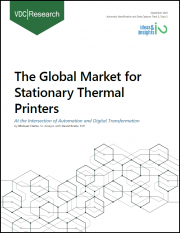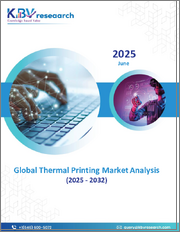
|
시장보고서
상품코드
1598397
세계의 서멀 프린트 시장 : 프린터 유형, 포맷 유형, 접속성, 용도, 최종 사용자별 예측(2025-2030년)Thermal Printing Market by Printer Type (Direct Thermal Printer, Thermal Transfer Printer), Format Type (Desktop Format, Industrial Format, Mobile Format), Connectivity, Application, End-User - Global Forecast 2025-2030 |
||||||
서멀 프린트 시장의 2023년 시장 규모는 408억 8,000만 달러로 평가되었습니다. 2024년에는 429억 6,000만 달러에 달할 것으로 예측되며, CAGR 5.27%로 성장하여 2030년에는 585억 9,000만 달러에 달할 것으로 예측됩니다.
서멀 프린트 시장에는 직접 서멀 프린트 및 열전사 인쇄와 같은 다양한 제품과 기술이 포함됩니다. 열을 이용하여 인쇄 이미지를 생성하는 디지털 인쇄 프로세스로 정의되는 서멀 프린트는 속도, 효율성, 비용 대비 효과로 비즈니스에 필수적입니다. 서멀 프린트는 소매업, 물류업, 헬스케어, 제조업 등 폭넓은 분야에서 이용되고 있으며, 바코드나 라벨 인쇄부터 영수증이나 ID 배지 작성까지 다양한 솔루션을 제공합니다. 서멀 프린트는 신뢰성이 높고 유지 보수의 필요성이 적기 때문에 최종 이용 산업에서 활용되고 있습니다. 공급망과 재고 관리의 필요성, 모바일 및 휴대용 인쇄 장치 수요 증가 등이 있습니다. 인쇄를 할 수 있기 때문에 새로운 기회를 제공합니다. 그러나 이 시장은 열과 빛에 대한 직접 감서멀 프린트 취약성과 잉크젯 및 레이저 인쇄 기술과의 치열한 경쟁과 같은 과제에 직면 해 있습니다. 친환경적인 요소 재료 및 에너지 효율이 높은 열 프린터의 분야에서는 기술 혁신이 진행되고 있으며, 환경 문제의 고조나 엄격한 규제에 대응하기 위해 노력하고 있습니다. 그리고 범용성 강화에 길을 열 수 있습니다 시장은 여전히 역동적이며 기술의 진보와 규제 변화가 그 궤도를 형성하고 있습니다. 개발을 위한 연구 개발에 투자하여 운송과 오락과 같은 미개척 분야의 응용 확대에 주력해야 합니다.
| 주요 시장 통계 | |
|---|---|
| 기준년(2023) | 408억 8,000만 달러 |
| 예측년(2024) | 429억 6,000만 달러 |
| 예측년(2030) | 585억 9,000만 달러 |
| CAGR(%) | 5.27% |
시장 역학: 빠르게 진화하는 서멀 프린트 시장의 주요 시장 인사이트 공개
서멀 프린트 시장은 수요 및 공급의 역동적인 상호 작용에 의해 변모를 이루고 있습니다. 비즈니스 기회를 얻을 수 있습니다. 이러한 동향을 종합적으로 파악함으로써 기업은 정치적, 지리적, 기술적, 사회적, 경제적 영역에 걸친 다양한 리스크를 경감할 수 있을 뿐만 아니라 소비자 행동과 그것이 제조 비용과 구매 동향에 미치는 영향을보다 명확하게 이해할 수 있습니다.
- 시장 성장 촉진요인
- 소매 및 E-Commerce 산업의 급성장
- RFID 기술과 POS 시스템의 채용 증가
- 제품의 안전성과 위조에 대한 우려 증가
- 시장 성장 억제요인
- 빈번한 유지보수 및 업그레이드 필요성
- 시장 기회
- 서멀 프린트 시스템의 기술적 진보
- 커스터마이즈나 온디맨드 인쇄를 위한 서멀 프린터의 이용이 증가
- 시장의 과제
- 서멀 프린트의 품질과 속도의 한계
Porter's Five Forces: 서멀 프린트 시장을 탐색하는 전략 도구
Porter's Five Forces는 서멀 프린트 시장 경쟁 구도를 이해하는 중요한 도구입니다.의 명확한 기술을 제공합니다. 프레임워크는 기업이 시장 내 세력도를 평가하고 신규 사업의 수익성을 판단하는데 도움이 됩니다. 더 강인한 시장에서 포지셔닝을 보장 할 수 있습니다.
PESTLE 분석 : 서멀 프린트 시장에서 외부 영향을 파악
외부 거시 환경 요인은 서멀 프린트 시장의 성과 역학을 형성하는 데 매우 중요한 역할을합니다. 탐색하는 데 필요한 정보를 제공합니다. PESTLE 요인을 조사하면 기업은 잠재적인 위험과 기회를 더 잘 이해할 수 있습니다. 을 예측하는 적극적인 의사 결정을 할 준비가되어 있습니다.
시장 점유율 분석 : 서멀 프린트 시장 경쟁 구도 파악
서멀 프린트 시장의 상세한 시장 점유율 분석을 통해 공급업체의 성과를 종합적으로 평가할 수 있습니다. 이를 통해 시장의 집중, 단편화, 통합 동향을 밝혀내고, 벤더는 경쟁이 격화하는 가운데 자신의 지위를 높이는 전략적 의사결정을 하기 위해 필요합니다. 지식을 얻을 수 있습니다.
FPNV 포지셔닝 매트릭스 : 서멀 프린트 시장에서 공급업체의 성능 평가
FPNV 포지셔닝 매트릭스는 서멀 프린트 시장에서 벤더를 평가하는 중요한 도구입니다. 기본 결정을 내릴 수 있습니다. 네 가지 사분면을 통해 벤더를 명확하고 정확하게 분할하고 전략 목표에 가장 적합한 파트너 및 솔루션을 파악할 수 있습니다.
전략 분석 및 권장 : 서멀 프린트 시장에서 성공에 대한 길을 그립니다.
서멀 프린트 시장의 전략 분석은 세계 시장에서의 프레즌스 강화를 목표로 하는 기업에 필수적인 요소입니다. 이러한 접근 방식을 통해 경쟁 구도에서 과제를 극복하고 새로운 비즈니스 기회를 활용하여 장기적인 성공을 거둘 수 있는 체제를 구축할 수 있습니다.
이 보고서는 주요 관심 분야를 포괄하는 시장의 종합적인 분석을 제공합니다.
1. 시장 침투: 현재 시장 환경의 상세한 검토, 주요 기업의 광범위한 데이터, 시장 도달범위 및 전반적인 영향력 평가.
2. 시장 개척도: 신흥 시장의 성장 기회를 파악하고 기존 분야의 확장 가능성을 평가하며 미래 성장을 위한 전략적 로드맵을 제공합니다.
3. 시장 다양화: 최근 제품 출시, 미개척 지역, 업계의 주요 진보, 시장을 형성하는 전략적 투자를 분석합니다.
4. 경쟁 평가 및 정보 : 경쟁 구도를 철저히 분석하여 시장 점유율, 사업 전략, 제품 포트폴리오, 인증, 규제 당국 승인, 특허 동향, 주요 기업의 기술 진보 등을 검증합니다.
5. 제품 개발 및 혁신 : 미래 시장 성장을 가속할 것으로 예상되는 최첨단 기술, R&D 활동, 제품 혁신을 강조합니다.
또한 이해관계자가 충분한 정보를 얻고 의사결정을 할 수 있도록 중요한 질문에 대답하고 있습니다.
1. 현재 시장 규모와 향후 성장 예측은?
2. 최고의 투자 기회를 제공하는 제품, 부문 및 지역은 어디입니까?
3. 시장을 형성하는 주요 기술 동향과 규제의 영향은?
4. 주요 벤더의 시장 점유율과 경쟁 포지션은?
5. 벤더 시장 진입·철수 전략의 원동력이 되는 수익원과 전략적 기회는 무엇인가?
목차
제1장 서문
제2장 조사 방법
제3장 주요 요약
제4장 시장 개요
제5장 시장 인사이트
- 시장 역학
- 성장 촉진요인
- 소매 및 전자상거래 업계의 급성장
- RFID 기술과 POS 시스템의 도입 증가
- 제품의 안전성과 위조품에 대한 우려 증가
- 억제요인
- 빈번한 유지보수 및 업그레이드 필요성
- 기회
- 서멀 프린트 시스템의 기술적 진보
- 커스터마이즈 인쇄나 온 디맨드 인쇄에 서멀 프린터가 이용되게 되어 왔습니다
- 과제
- 서멀 프린트 품질 및 속도 제한
- 성장 촉진요인
- 시장 세분화 분석
- Porter's Five Forces 분석
- PESTEL 분석
- 정치적
- 경제
- 사교
- 기술적
- 법률상
- 환경
제6장 서멀 프린트 시장 : 프린터 유형별
- 직접 서멀 프린터
- 열전사 프린터
제7장 서멀 프린트 시장 : 포맷 유형별
- 데스크톱 형식
- 산업용 포맷
- 모바일 포맷
제8장 서멀 프린트 시장 : 접속성별
- 유선
- 무선
제9장 서멀 프린트 시장 : 용도별
- 바코드 인쇄
- 카드 인쇄
- 키오스크와 티켓 인쇄
- 판매 시점 영수증 인쇄
- RFID 인쇄
제10장 서멀 프린트 시장 : 최종 사용자별
- 헬스케어
- 제조업
- 소매
- 교통기관
- 여행 및 호스피탈리티
제11장 아메리카의 서멀 프린트 시장
- 아르헨티나
- 브라질
- 캐나다
- 멕시코
- 미국
제12장 아시아태평양의 서멀 프린트 시장
- 호주
- 중국
- 인도
- 인도네시아
- 일본
- 말레이시아
- 필리핀
- 싱가포르
- 한국
- 대만
- 태국
- 베트남
제13장 유럽·중동 및 아프리카의 서멀 프린트 시장
- 덴마크
- 이집트
- 핀란드
- 프랑스
- 독일
- 이스라엘
- 이탈리아
- 네덜란드
- 나이지리아
- 노르웨이
- 폴란드
- 카타르
- 러시아
- 사우디아라비아
- 남아프리카
- 스페인
- 스웨덴
- 스위스
- 터키
- 아랍에미리트(UAE)
- 영국
제14장 경쟁 구도
- 시장 점유율 분석 2023
- FPNV 포지셔닝 매트릭스, 2023
- 경쟁 시나리오 분석
- 전략 분석과 제안
기업 목록
- Avery Dennison Corporation
- Bixolon Co. Ltd.
- BlueStar Inc.
- Brother International Corporation
- Docod Precision Group Co., Ltd.
- Fujitsu Limited
- GuangZhou Winprt Technology Co., Ltd.
- Honeywell International Inc.
- HSPOS Technology Limited
- Hwasung System
- KFISrl
- MUNBYN
- NCR Corporation
- NETUM
- Phomemo
- POS-X, Inc.
- Rongta Technology(Xiamen) Group Co.,Ltd.
- SATO Holdings Corporation
- Seiko Epson Corporation
- Shenzhen Hoin Electronic Technology Co., Ltd.
- TE Connectivity Ltd.
- Toshiba TEC Corporation
- TSC Auto ID Technology Co., Ltd.
- Wasp Barcode Technologies
- Xiamen Hanin Electronic Technology Co.,Ltd.
- Xiamen YAEN Electronic Technology Co., Ltd.
- Xprinter Group
- Zebra Technologies Corporation
The Thermal Printing Market was valued at USD 40.88 billion in 2023, expected to reach USD 42.96 billion in 2024, and is projected to grow at a CAGR of 5.27%, to USD 58.59 billion by 2030.
The scope of the thermal printing market encompasses a range of products and technologies, including direct thermal and thermal transfer printing. Defined as a digital printing process that uses heat to produce printed images, thermal printing is essential for businesses due to its speed, efficiency, and cost-effectiveness. Its application spans across retail, logistics, healthcare, and manufacturing sectors, offering solutions from barcode and label printing to producing receipts and ID badges. End-use industries leverage thermal printing for its reliability and minimal maintenance requirements. In terms of market growth, key factors include the surge in e-commerce, the need for efficient supply chain and inventory management, and heightened demand for mobile and portable printing devices. The advent of IoT in industrial sectors provides new opportunities, as thermal printers can seamlessly integrate with smart devices for real-time data processing and printing. However, the market faces limitations such as the vulnerability of direct thermal prints to heat and light exposure and challenges in terms of heavy competition from inkjet and laser printing technologies. Innovation is ripe in the areas of eco-friendly materials and energy-efficient thermal printers, which address growing environmental concerns and compliance with stringent regulations. Additionally, research into advanced thermal heads and printed electronics can pave the way for enhanced performance and versatility. The market remains dynamic, with technological advancements and regulatory changes shaping its trajectory. Companies should invest in R&D to develop innovative solutions like RFID-enabled labels and focus on expanding applications in untapped sectors like transportation and entertainment. By staying adaptable to emerging trends and maintaining a keen eye on consumer needs, businesses can secure a competitive edge in the evolving thermal printing market.
| KEY MARKET STATISTICS | |
|---|---|
| Base Year [2023] | USD 40.88 billion |
| Estimated Year [2024] | USD 42.96 billion |
| Forecast Year [2030] | USD 58.59 billion |
| CAGR (%) | 5.27% |
Market Dynamics: Unveiling Key Market Insights in the Rapidly Evolving Thermal Printing Market
The Thermal Printing Market is undergoing transformative changes driven by a dynamic interplay of supply and demand factors. Understanding these evolving market dynamics prepares business organizations to make informed investment decisions, refine strategic decisions, and seize new opportunities. By gaining a comprehensive view of these trends, business organizations can mitigate various risks across political, geographic, technical, social, and economic domains while also gaining a clearer understanding of consumer behavior and its impact on manufacturing costs and purchasing trends.
- Market Drivers
- Exponential growth of the retail & eCommerce industry
- Rising adoption of RFID technology and point-of-sale systems
- Growing concerns associated with product safety and counterfeit
- Market Restraints
- Need for frequent maintenance and upgradation
- Market Opportunities
- Technological advancements in thermal printing systems
- Emerging use of thermal printers for customized and on-demand printing
- Market Challenges
- Thermal print quality and speed limitations
Porter's Five Forces: A Strategic Tool for Navigating the Thermal Printing Market
Porter's five forces framework is a critical tool for understanding the competitive landscape of the Thermal Printing Market. It offers business organizations with a clear methodology for evaluating their competitive positioning and exploring strategic opportunities. This framework helps businesses assess the power dynamics within the market and determine the profitability of new ventures. With these insights, business organizations can leverage their strengths, address weaknesses, and avoid potential challenges, ensuring a more resilient market positioning.
PESTLE Analysis: Navigating External Influences in the Thermal Printing Market
External macro-environmental factors play a pivotal role in shaping the performance dynamics of the Thermal Printing Market. Political, Economic, Social, Technological, Legal, and Environmental factors analysis provides the necessary information to navigate these influences. By examining PESTLE factors, businesses can better understand potential risks and opportunities. This analysis enables business organizations to anticipate changes in regulations, consumer preferences, and economic trends, ensuring they are prepared to make proactive, forward-thinking decisions.
Market Share Analysis: Understanding the Competitive Landscape in the Thermal Printing Market
A detailed market share analysis in the Thermal Printing Market provides a comprehensive assessment of vendors' performance. Companies can identify their competitive positioning by comparing key metrics, including revenue, customer base, and growth rates. This analysis highlights market concentration, fragmentation, and trends in consolidation, offering vendors the insights required to make strategic decisions that enhance their position in an increasingly competitive landscape.
FPNV Positioning Matrix: Evaluating Vendors' Performance in the Thermal Printing Market
The Forefront, Pathfinder, Niche, Vital (FPNV) Positioning Matrix is a critical tool for evaluating vendors within the Thermal Printing Market. This matrix enables business organizations to make well-informed decisions that align with their goals by assessing vendors based on their business strategy and product satisfaction. The four quadrants provide a clear and precise segmentation of vendors, helping users identify the right partners and solutions that best fit their strategic objectives.
Strategy Analysis & Recommendation: Charting a Path to Success in the Thermal Printing Market
A strategic analysis of the Thermal Printing Market is essential for businesses looking to strengthen their global market presence. By reviewing key resources, capabilities, and performance indicators, business organizations can identify growth opportunities and work toward improvement. This approach helps businesses navigate challenges in the competitive landscape and ensures they are well-positioned to capitalize on newer opportunities and drive long-term success.
Key Company Profiles
The report delves into recent significant developments in the Thermal Printing Market, highlighting leading vendors and their innovative profiles. These include Avery Dennison Corporation, Bixolon Co. Ltd., BlueStar Inc., Brother International Corporation, Docod Precision Group Co., Ltd., Fujitsu Limited, GuangZhou Winprt Technology Co., Ltd., Honeywell International Inc., HSPOS Technology Limited, Hwasung System, K.F.I. S.r.l., MUNBYN, NCR Corporation, NETUM, Phomemo, POS-X, Inc., Rongta Technology (Xiamen) Group Co.,Ltd., SATO Holdings Corporation, Seiko Epson Corporation, Shenzhen Hoin Electronic Technology Co., Ltd., TE Connectivity Ltd., Toshiba TEC Corporation, TSC Auto ID Technology Co., Ltd., Wasp Barcode Technologies, Xiamen Hanin Electronic Technology Co.,Ltd., Xiamen YAEN Electronic Technology Co., Ltd., Xprinter Group, and Zebra Technologies Corporation.
Market Segmentation & Coverage
This research report categorizes the Thermal Printing Market to forecast the revenues and analyze trends in each of the following sub-markets:
- Based on Printer Type, market is studied across Direct Thermal Printer and Thermal Transfer Printer.
- Based on Format Type, market is studied across Desktop Format, Industrial Format, and Mobile Format.
- Based on Connectivity, market is studied across Wired and Wireless.
- Based on Application, market is studied across Barcode Printing, Card Printing, Kiosk & Ticket Printing, Point of Sale Receipt Printing, and RFID Printing.
- Based on End-User, market is studied across Healthcare, Manufacturing, Retail, Transportation, and Travel & Hospitality.
- Based on Region, market is studied across Americas, Asia-Pacific, and Europe, Middle East & Africa. The Americas is further studied across Argentina, Brazil, Canada, Mexico, and United States. The United States is further studied across California, Florida, Illinois, New York, Ohio, Pennsylvania, and Texas. The Asia-Pacific is further studied across Australia, China, India, Indonesia, Japan, Malaysia, Philippines, Singapore, South Korea, Taiwan, Thailand, and Vietnam. The Europe, Middle East & Africa is further studied across Denmark, Egypt, Finland, France, Germany, Israel, Italy, Netherlands, Nigeria, Norway, Poland, Qatar, Russia, Saudi Arabia, South Africa, Spain, Sweden, Switzerland, Turkey, United Arab Emirates, and United Kingdom.
The report offers a comprehensive analysis of the market, covering key focus areas:
1. Market Penetration: A detailed review of the current market environment, including extensive data from top industry players, evaluating their market reach and overall influence.
2. Market Development: Identifies growth opportunities in emerging markets and assesses expansion potential in established sectors, providing a strategic roadmap for future growth.
3. Market Diversification: Analyzes recent product launches, untapped geographic regions, major industry advancements, and strategic investments reshaping the market.
4. Competitive Assessment & Intelligence: Provides a thorough analysis of the competitive landscape, examining market share, business strategies, product portfolios, certifications, regulatory approvals, patent trends, and technological advancements of key players.
5. Product Development & Innovation: Highlights cutting-edge technologies, R&D activities, and product innovations expected to drive future market growth.
The report also answers critical questions to aid stakeholders in making informed decisions:
1. What is the current market size, and what is the forecasted growth?
2. Which products, segments, and regions offer the best investment opportunities?
3. What are the key technology trends and regulatory influences shaping the market?
4. How do leading vendors rank in terms of market share and competitive positioning?
5. What revenue sources and strategic opportunities drive vendors' market entry or exit strategies?
Table of Contents
1. Preface
- 1.1. Objectives of the Study
- 1.2. Market Segmentation & Coverage
- 1.3. Years Considered for the Study
- 1.4. Currency & Pricing
- 1.5. Language
- 1.6. Stakeholders
2. Research Methodology
- 2.1. Define: Research Objective
- 2.2. Determine: Research Design
- 2.3. Prepare: Research Instrument
- 2.4. Collect: Data Source
- 2.5. Analyze: Data Interpretation
- 2.6. Formulate: Data Verification
- 2.7. Publish: Research Report
- 2.8. Repeat: Report Update
3. Executive Summary
4. Market Overview
5. Market Insights
- 5.1. Market Dynamics
- 5.1.1. Drivers
- 5.1.1.1. Exponential growth of the retail & eCommerce industry
- 5.1.1.2. Rising adoption of RFID technology and point-of-sale systems
- 5.1.1.3. Growing concerns associated with product safety and counterfeit
- 5.1.2. Restraints
- 5.1.2.1. Need for frequent maintenance and upgradation
- 5.1.3. Opportunities
- 5.1.3.1. Technological advancements in thermal printing systems
- 5.1.3.2. Emerging use of thermal printers for customized and on-demand printing
- 5.1.4. Challenges
- 5.1.4.1. Thermal print quality and speed limitations
- 5.1.1. Drivers
- 5.2. Market Segmentation Analysis
- 5.3. Porter's Five Forces Analysis
- 5.3.1. Threat of New Entrants
- 5.3.2. Threat of Substitutes
- 5.3.3. Bargaining Power of Customers
- 5.3.4. Bargaining Power of Suppliers
- 5.3.5. Industry Rivalry
- 5.4. PESTLE Analysis
- 5.4.1. Political
- 5.4.2. Economic
- 5.4.3. Social
- 5.4.4. Technological
- 5.4.5. Legal
- 5.4.6. Environmental
6. Thermal Printing Market, by Printer Type
- 6.1. Introduction
- 6.2. Direct Thermal Printer
- 6.3. Thermal Transfer Printer
7. Thermal Printing Market, by Format Type
- 7.1. Introduction
- 7.2. Desktop Format
- 7.3. Industrial Format
- 7.4. Mobile Format
8. Thermal Printing Market, by Connectivity
- 8.1. Introduction
- 8.2. Wired
- 8.3. Wireless
9. Thermal Printing Market, by Application
- 9.1. Introduction
- 9.2. Barcode Printing
- 9.3. Card Printing
- 9.4. Kiosk & Ticket Printing
- 9.5. Point of Sale Receipt Printing
- 9.6. RFID Printing
10. Thermal Printing Market, by End-User
- 10.1. Introduction
- 10.2. Healthcare
- 10.3. Manufacturing
- 10.4. Retail
- 10.5. Transportation
- 10.6. Travel & Hospitality
11. Americas Thermal Printing Market
- 11.1. Introduction
- 11.2. Argentina
- 11.3. Brazil
- 11.4. Canada
- 11.5. Mexico
- 11.6. United States
12. Asia-Pacific Thermal Printing Market
- 12.1. Introduction
- 12.2. Australia
- 12.3. China
- 12.4. India
- 12.5. Indonesia
- 12.6. Japan
- 12.7. Malaysia
- 12.8. Philippines
- 12.9. Singapore
- 12.10. South Korea
- 12.11. Taiwan
- 12.12. Thailand
- 12.13. Vietnam
13. Europe, Middle East & Africa Thermal Printing Market
- 13.1. Introduction
- 13.2. Denmark
- 13.3. Egypt
- 13.4. Finland
- 13.5. France
- 13.6. Germany
- 13.7. Israel
- 13.8. Italy
- 13.9. Netherlands
- 13.10. Nigeria
- 13.11. Norway
- 13.12. Poland
- 13.13. Qatar
- 13.14. Russia
- 13.15. Saudi Arabia
- 13.16. South Africa
- 13.17. Spain
- 13.18. Sweden
- 13.19. Switzerland
- 13.20. Turkey
- 13.21. United Arab Emirates
- 13.22. United Kingdom
14. Competitive Landscape
- 14.1. Market Share Analysis, 2023
- 14.2. FPNV Positioning Matrix, 2023
- 14.3. Competitive Scenario Analysis
- 14.4. Strategy Analysis & Recommendation
Companies Mentioned
- 1. Avery Dennison Corporation
- 2. Bixolon Co. Ltd.
- 3. BlueStar Inc.
- 4. Brother International Corporation
- 5. Docod Precision Group Co., Ltd.
- 6. Fujitsu Limited
- 7. GuangZhou Winprt Technology Co., Ltd.
- 8. Honeywell International Inc.
- 9. HSPOS Technology Limited
- 10. Hwasung System
- 11. K.F.I. S.r.l.
- 12. MUNBYN
- 13. NCR Corporation
- 14. NETUM
- 15. Phomemo
- 16. POS-X, Inc.
- 17. Rongta Technology (Xiamen) Group Co.,Ltd.
- 18. SATO Holdings Corporation
- 19. Seiko Epson Corporation
- 20. Shenzhen Hoin Electronic Technology Co., Ltd.
- 21. TE Connectivity Ltd.
- 22. Toshiba TEC Corporation
- 23. TSC Auto ID Technology Co., Ltd.
- 24. Wasp Barcode Technologies
- 25. Xiamen Hanin Electronic Technology Co.,Ltd.
- 26. Xiamen YAEN Electronic Technology Co., Ltd.
- 27. Xprinter Group
- 28. Zebra Technologies Corporation



















